This article aims to explore how a structural engineer should approach the strengthening of existing structures as well as the major techniques that can be employed in strengthening an existing structure in order to ensure the overall safety and durability.
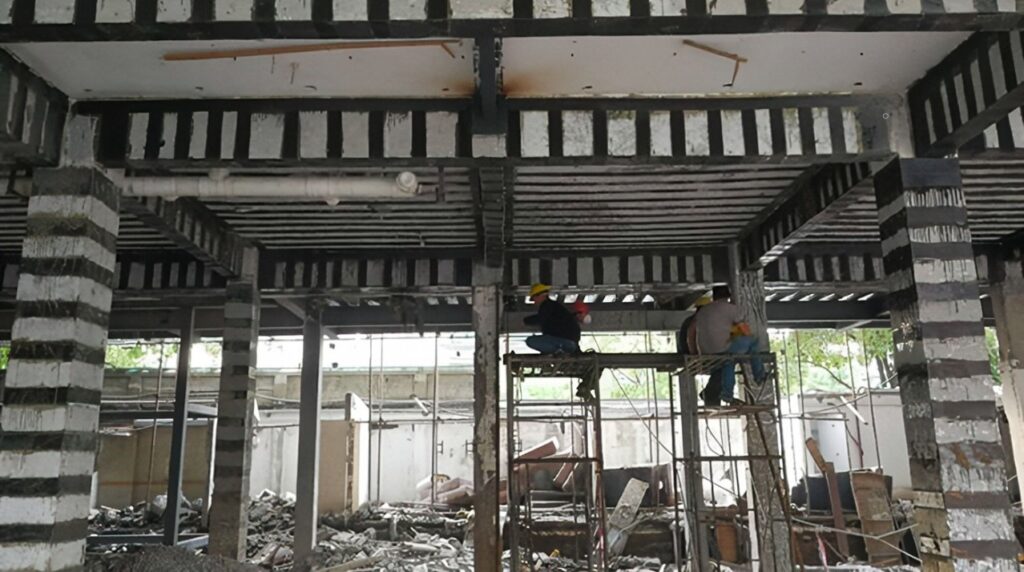
It is no longer open to for debate that extending the life of our existing structures is better than rebuilding them. Reusing existing structures is not only better than ‘new construction’ from the angle of cost considerations but also from the viewpoint of reducing the impact on the environmental as a result of construction activities.
In order to ensure that an existing building is fit for purpose, an appraisal of the existing structure must be conducted (See: A Background to the Appraisal of Existing Building). The aim of the appraisal is to identify the potential of the existing structure for reuse bearing in mind any modification that may be sought. The result of the appraisal would either recommend a new construction ahead of the existing structure or declare it fit for reuse. Where the existing structure is fit reuse, strengthening is almost inevitable.
Strengthening is a key component in the reuse of existing building. It is the only way the risks associated with reusing an existing structure, such as changes to use, compliance with modern codes and any unforeseen environmental load that might not have been there during the time of original construction can be mitigated.
This article aims to explore how a structural engineer should approach the strengthening of existing structures as well as the major techniques that can be employed in strengthening an existing structure in order to ensure safety and durability.
Procedural Aspects of Strengthening Existing Structures
There are five levels in the exercise of strengthening an existing structure. These five considerations must be carefully considered, because the strengthening technique to adopt is always contingent on what the structural engineer is able to uncover at this level.
Structural Assessment
The cornerstone of any successful strengthening procedure depends on the ability of the structural engineer to conduct a comprehensive structural assessment. This is often done at the level of appraisal of an existing structure. It involves a thorough examination of the existing building, including materials, load-bearing capacity, and vulnerability to external forces. Engineers and other project team members meticulously inspect the structure to identify zones of weaknesses, and assess the impact of environmental factors, towards determining the appropriate strengthening measures to be followed.
Material Selection
Choosing the right materials is a pivotal decision that significantly influences the success of a strengthening procedure. Material selection is based on a combination of factors, including the type of structure, environmental conditions, and the specific challenges the building faces or is bound to face. From traditional construction materials to cutting-edge composites, the chosen materials must align with the project’s goals and engineering requirements.
Design Considerations
The design phase is where the blueprint for the strengthening procedure takes shape. Engineers use the information gathered from the structural assessment to create detailed plans. This includes specifying the placement of reinforcement elements, calculating load distribution and redistribution, and ensuring compliance with the current building codes and standards. A well-thought-out design must lay a good foundation for a successful and structurally sound strengthening procedure.
Construction Process
The execution of the construction process is also very crucial stage, often demanding care, precision, and expertise. Coordination of the works among different construction teams is essential to ensure the safety of workers and the integrity of the structure during the strengthening process.
Rigorous quality control measures are imperative throughout the construction phase. Testing materials for strength and durability, ensuring the proper installation of strengthening elements, and conducting structural tests are essential components of this phase. Quality control not only validates the effectiveness of the strengthening measures but also identifies any potential issues that may arise during the structure’s lifecycle.
Maintenance and Monitoring
Once the strengthening procedure has been completed, a proactive maintenance and monitoring program becomes part of the process. Regular inspections, structural health monitoring, and timely repairs are crucial for the long-term success of the strengthening project. This ensures that the structure continues to meet safety standards and adapts to changing environmental conditions.
Strengthening Techniques
Having considered the procedural issues, the structural engineer can then select the most appropriate strengthening technique. And there are a number of them:
External Post-tensioning
One of the effective methods for strengthening building structures is external post-tensioning. This technique involves applying high-strength tendons, typically made of steel, to the exterior of a structure (Figure 1). The tendons are anchored at both ends, creating a compressive force that counteracts external loads.
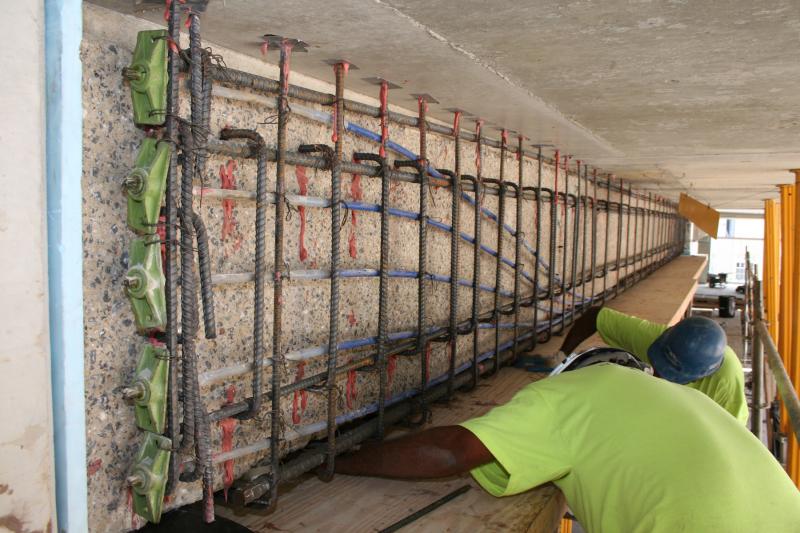
External post-tensioning offers several distinct advantages. Firstly, it allows for the enhancement of a structure’s load-carrying capacity without the need for major alterations to the existing structure, minimizing disruptions and reduction in construction costs. Additionally, the external application of tendons facilitates easier inspection and maintenance, as the strengthening elements remain accessible. Also, its adaptability makes it suitable for various types of structures, ranging from bridges and parking structures to commercial buildings.
Fiber Reinforced Polymers (FRP)
Fiber Reinforced Polymers (FRP) have gained widespread acceptance in the field of strengthening as a result of their high strength-to-weight ratio and corrosion resistance. This technique uses Carbon or glass fibers embedded in a polymer matrix and then applied to structural elements like beams, columns, or slabs (Figure 2). FRP provides additional tensile strength and flexural capacity, enhancing the overall performance of the structure while being lightweight and easy to install. The result is a composite material that significantly improves the tensile strength and flexural capacity of the structure. FRP strengthening is particularly valuable in addressing the challenges posed by aging infrastructure, seismic vulnerabilities, and changes in usage requirements. Its non-corrosive nature also makes it an ideal choice for reinforcing structures in corrosive environments.
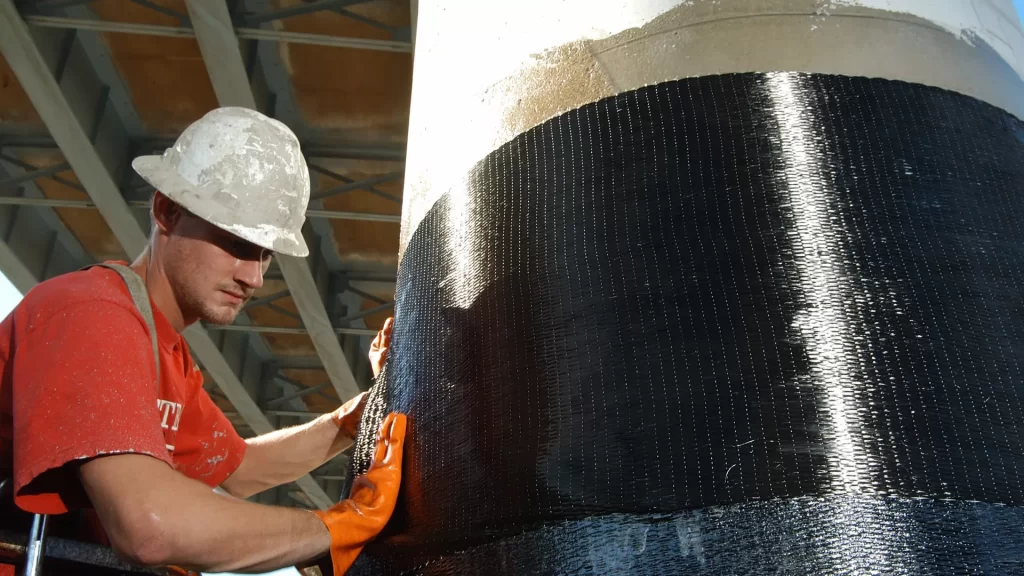
One of the key advantages of the FRP strengthening method lies in its efficiency and ease of application. The lightweight nature of FRP materials minimizes additional dead load on the structure, allowing for seamless integration without overburdening the existing structure. Its durability and corrosion resistance also contribute to its long-term effectiveness, ensuring that the strengthened elements withstand environmental challenges while offering a cost-effective alternative to traditional retrofitting methods.
Jacketing of Columns and Beams
Column and beam jacketing involve the addition of a new layer of material, typically reinforced concrete, around existing structural elements (Figure 3). This method enhances the load-carrying capacity of columns and beams, providing increased resistance to external forces. Jacketing is often employed when the original structural elements are deemed inadequate for current load requirements or when additional strength is necessary to meet updated safety standards.

The key advantages of the jacketing method lie in its adaptability to various types of structures, including both reinforced concrete and steel-frames. The additional layer of reinforced concrete serves to increase the structural strength and stiffness of the columns and beams, making them better equipped to handle increased loads and forces. This method is often applied strategically to critical structural elements, ensuring targeted reinforcement where it is most needed. Jacketing provides an aesthetically pleasing solution, as the added layer can be designed to blend seamlessly with the existing features of the building.
Base Isolation
Base isolation is a seismic strengthening technique designed to minimize a building’s exposure to ground motion during an earthquake. Flexible bearings or isolators are installed at the foundation level, allowing the structure to move independently of the ground (Figure 4). This isolation reduces the transmission of seismic forces to the building, significantly improving its chances of survival during an earthquake. Base isolation is especially crucial for structures in earthquake-prone regions.
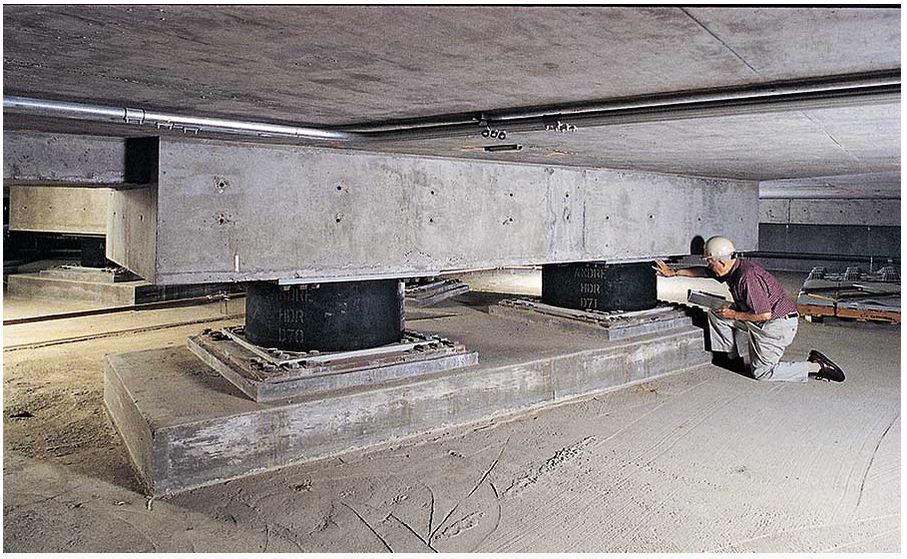
The advantages of base isolation are manifold. Not only does it provide an effective means of protecting structures against seismic forces, but it also allows for a more straightforward and cost-effective strengthening process compared to traditional methods. The seismic isolators are typically placed between the foundation and the superstructure, and their adaptability to different building configurations makes them suitable for both new constructions and the retrofitting of existing structures. Additionally, base isolation preserves the architectural and aesthetic integrity of buildings, as it mitigates the need for extensive modifications to the superstructure.
Foundation Underpinning
Underpinning is a foundational strengthening method employed in structural engineering to enhance the stability and load-bearing capacity of existing buildings. This technique becomes crucial when the original foundation is compromised due to soil-related issues, structural settlement, or changes in load distribution. Underpinning involves the strategic reinforcement or extension of the existing foundation to redistribute loads and provide additional support to the structure (Figure 5). This process is typically executed by excavating beneath the building’s foundation in sections and introducing new material, such as concrete, to create a more stable and secure base. Underpinning ensures that a building’s foundation can adequately support its structure, preventing further settlement and addressing concerns related to subsidence or soil instability.
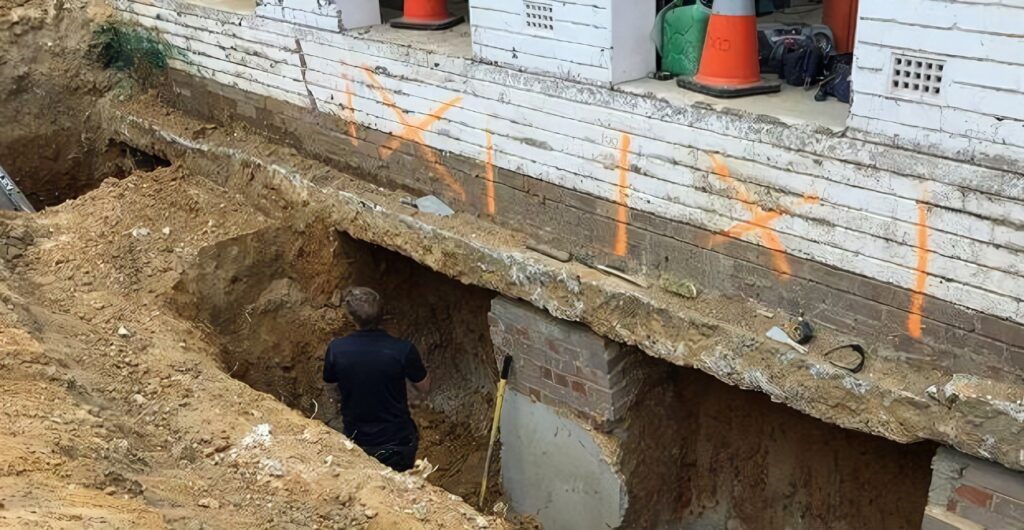
One of the significant advantages of underpinning is its versatility and adaptability to various foundation-related challenges. Whether a building is experiencing differential settlement, foundation cracks, or inadequate support due to changes in soil conditions, underpinning offers a tailored solution to rectify these issues. The method is often employed in historical or heritage buildings where preserving the existing structure is paramount, and extensive foundation replacement is neither practical nor desirable. Underpinning not only addresses current structural concerns but also provides a long-term solution, reinforcing the foundation to meet contemporary safety standards and ensuring the continued stability of the building over time.
Carbon Fiber Reinforcement for Masonry
Masonry structures often require special attention during strengthening, and carbon fiber reinforcement has emerged as a valuable solution. Strips or grids of carbon fiber are bonded to the surface of masonry walls, enhancing their tensile strength and crack resistance (Figure 6). This method is particularly beneficial for historical buildings where preserving the original aesthetics is crucial.
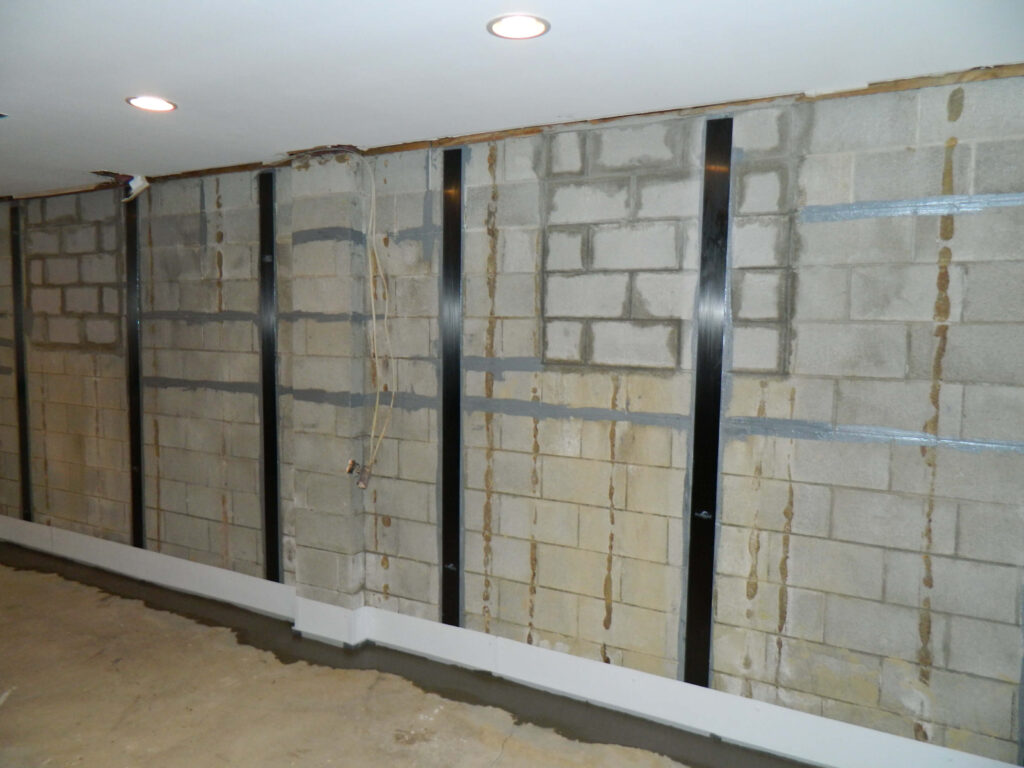
The use of carbon fiber reinforcement for masonry strengthening offers several notable benefits. The lightweight nature of CFRP minimizes additional loads on the structure, ensuring that the process does not compromise the original design specifications. Furthermore, the application is non-intrusive, allowing for efficient and cost-effective strengthening without the need for extensive structural modifications.
Concrete Strengthening with Shotcrete
Shotcrete, a technique involving the application of high-velocity concrete or mortar to a surface, is employed to strengthen and retrofit existing concrete structures. This method provides an additional layer of protection against deterioration, corrosion, and structural deficiencies. Shotcrete is versatile and can be applied to various surfaces, including vertical, overhead, and curved structures.
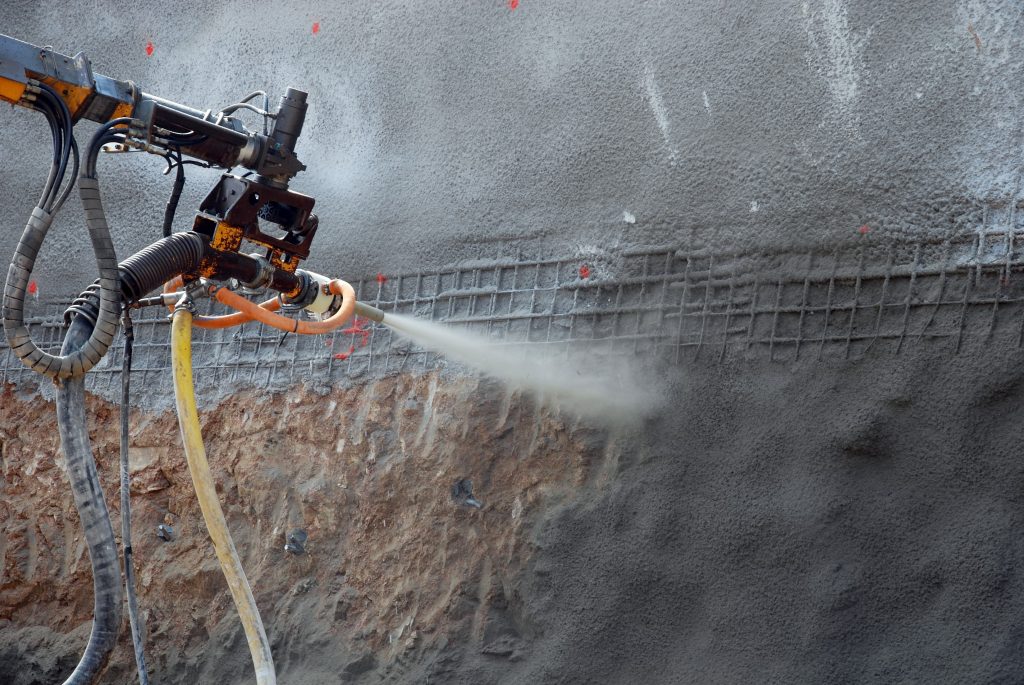
The key advantages of strengthening with shotcrete lies in its adaptability to various surfaces and configurations. The high-velocity application allows for the precise deposition of the material, making it suitable for vertical, overhead, and curved surfaces. This flexibility makes shotcrete an ideal solution for strengthening a wide range of structures, including bridges, tunnels, and building facades. The process is relatively quick and minimally disruptive compared to traditional methods, enabling efficient retrofitting without significant downtime. Additionally, shotcrete provides a seamless and durable finish, contributing to the extended service life of the structure.
Conclusion
Strengthening of structures is central to ensuring the safety, resilience, and longevity of structures. Every structure will present its own unique requirements, hazards, and possibilities. It’s important that the procedural factors are always considered prior to selecting a strengthening technique. Numerous technical materials and references are accessible to guide the procedure, regardless of the complexity of the threats or strengthening measures. It is incumbent upon all of us to utilize our current structures more effectively.